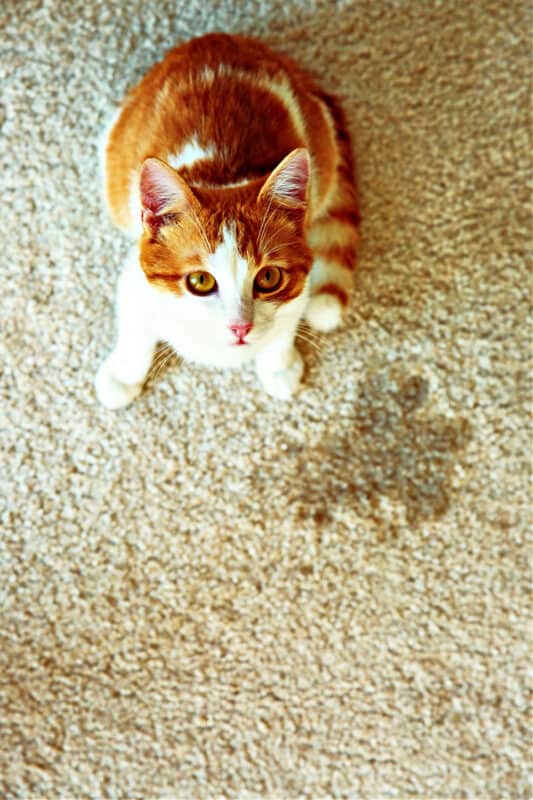Combat cat urine issues with confidence, cat owners. We've all been there: your beloved pet suddenly starts using the floor or furniture as a bathroom, and panic sets in. What's happening? Is it sickness, stress, or something else? Cleaning up cat urine can feel like an ongoing battle, and the smell might linger for days.
But what if there's a way to handle this messy problem with ease? In this guide, we'll uncover why cats sometimes miss the litter pan, and we'll provide simple solutions to clean up cat urine stains.
We'll even explore the common household items that should NOT be used for clean-up. Ready to declare victory over cat pee? Keep reading.

Understanding the Challenge: When Cats Miss the Litter Pan
Cats are delightful companions, bringing joy and comfort to our daily lives. Yet, sometimes they fall ill or become stressed, and their behavior can take an unexpected turn. The bladder often becomes the focal point for stress, leading to unwanted accidents around the house.
Imagine finding your cat relieving herself in the bathtub, shower, or sink. While these surfaces are usually easy to clean due to their non-porous nature, it might be a sign of a more serious problem.
A quick clean-up with a regular household cleaner might solve the immediate issue but don't dismiss it too quickly. Your cat's choice to miss the litter pan could be an indication of a Urinary Tract Infection (UTI).
Before getting angry or jumping to conclusions about behavioral problems, it's essential to rule out medical issues first. A visit to the veterinarian can help you understand if there's a health-related reason for the accident.
The Internet is filled with resources explaining why cats might miss the litter box, but our focus here is on practical solutions for cleaning up the mess. In particular, we'll explore how to deal with one of the most troublesome spots for cat owners - the carpet.
It's more than just a stain; it's about understanding your cat's needs and responding with empathy and effectiveness.

Be Combat Ready! Arm your Cat Pee Preparation Box!
Forewarned is forearmed, what you need in your arsenal are the following items:
A black light - A black light with a fluorescent tube, not an incandescent tube is what you need. The black light will (when turned on in complete darkness) make cat pee glow bright yellow for new stains, and light yellow or even green for old stains.
Rubber gloves - Cat urine is caustic. You want to be wearing rubber gloves anytime you are removing cat urine.
Sponges - if you have cat pee on your floor or carpet, you have a cat that is either ill and can’t help herself from peeing wherever she may be, or she is stressed about something going on.
If you see your cat peeing on your rug or carpet, don’t shout at her and rush over to move to the litter pan. Simply grab an absorbent sponge and slide it under her, so most of the cat pee catches in the sponge.
Cat pee is very caustic and it travels quickly. If you can catch it before that happens, you are ahead of the game. That is why sponges come in handy in the battle of the cat pee.
SIGN UP FOR THECATSITE'S EMAIL UPDATES >
Cloth diapers - these are the best as far as absorbent cloths go. Have a stack in your Combat Cat Pee Box.
Neutralizers - You need one of the following neutralizers: Anti-Icky Poo, Nature’s Miracle, Zero-Odor, or Urine-Off! These are all molecular-based neutralizers that break down the enzymes in the urine, dissolving them completely and eradicating the smell. These are all products that I have used, and I know from experience that they work.
Feliway Spray - this is the finisher for cat urine odor. After the neutralizer has had a chance to work, Feliway Spray is applied to the area.
Target Areas to Clean
Tile Floors
When it comes to tile floors, getting rid of cat urine is simple. Soak up the urine with an absorbent diaper, and then rinse with hot water and household cleaner. After that has dried, apply a neutralizer to the area to remove any lingering odor.

Carpets: A Complex Challenge
For carpets, cat urine is much more difficult to remove. Not only do you have to worry about the carpet fiber, but also the carpet backing and the padding which can quickly become saturated with cat pee resulting in bacteria, corrosion, and mold.
First, blot up as much of the cat urine as you possibly can with the cloth diapers.
Next, apply the neutralizer. Make sure that you allow the solution to soak through. Give it about 5 minutes to sit on the stain, and then take another cloth diaper and blot the area gently. Continue blotting (not rubbing) the area until it is completely dry. You may have to repeat this process more than once.
Finally, spray the area with Feliway Spray and then cover the area with a thin sheet or blanket, weighted down for at least six hours.
Walls and Baseboards
If the cat urine is near the wall or baseboard, you would be wise to scrub both of these down. Cat pee can really travel. If you are removing cat pee off your floors and rugs, chances are your cat is ill and needs a vet. However, if the cat's urine is on the walls 2’ up and higher, your cat is spraying and marking his/her territory. If that cat is intact sexually, then the cat needs to be neutered or spayed. Yes, females can also spray cat urine.
Throw Rugs and Area Rugs
Your best bet for these is to take them outside and clean them. Then let them air-dry for at least 24 hours if not longer. If the rugs are backed in rubber, you may as well either, after they are cleaned and neutralized, store them in the garage or throw them away. Rubber-backed rugs invite cat pee.
Hardwood Floors
Urine-Off will work on hardwood floors to pull the stain and odor out. It generally takes two treatments to do so. Once the stain has been dissolved and the floor has dried, then you have to see if sanding and re-varnishing the floor is going to be in order.
Soft Items: Understanding and Cleaning
Soft items include clothes, your bed, and beanbag chairs. If your cat is peeing on your clothes, more than likely she is stressed. This peeing on your scent is a way that she calms down. The two scents mixed together will soothe her. Most owners become quite irate when their cat is peeing on clean clothes or their beds. Reacting negatively to this situation will only increase the frequency of it occurring.
Focus on the Solution to Each Cat Urine Problem
Handling Washable Items
If the item can be washed, then throw it in the washing machine. Use a laundry detergent made to wash diapers. Air-dry the item instead of putting it in the dryer.
Dealing with Beds and Chairs
If the item is a bed or a chair, this gets a bit trickier. You need to blot up the urine as quickly as possible. Never rub urine it will just make it harder to remove. Then use a neutralizer and cover the area. Take a large heavy blanket and place it over the area, but leave breathing room underneath. Use books to make an opening under the blanket so the air can get through. Keep the cats out of the room for at least 8 hours while this is working, then uncover and spray Feliway Spray in the pee area.
Anytime you are working on a cat urine stain, be sure your cat stays out of the room. If you don’t isolate her from the area, the first time your back is turned, she might go over to the scene of the crime, and pee on the spot for you. Isn’t that special? But that is what could happen.
What Not to Use
Do not use ammonia, vinegar, hydrogen peroxide, FeBreeze, or lemon juice to remove cat urine. Ammonia and vinegar will encourage your cat to continue to pee on the spot, and the other products will cover up the smell for Your satisfaction, but not for your cat’s incredible olfactory unit. If she even gets a hint of urine scent, she will return every three days to refresh it.
Preventing Repeated Incidents
If your cat persists in peeing in the same spot, and you have taken her to the vet to be sure she is not ill, invest in a computer mat and flip it upside down on the spot she is using as her bathroom. She will not like the feel of the rubber prongs against her pads and will stop using the spot.

Warnings and Precautions: Avoid These Common Mistakes in Cat Urine Cleaning
Cleaning cat urine is not just about getting rid of the smell and stains. It's also about using methods that are safe for both you and your beloved pet.
Here are some substances and techniques you should avoid:
- Ammonia & Vinegar: These substances may encourage your cat to continue peeing in the same spot. While they might seem like effective cleaning agents, they can exacerbate the problem by appealing to your cat's sense of smell.
- Hydrogen Peroxide, FeBreeze, or Lemon Juice: These might mask the smell for human noses but not for your cat's incredible olfactory unit. Using these products can leave a residual scent that attracts your cat back to the same spot.
- Rubbing the Stain: Never rub a urine stain, as it can push the urine deeper into the fibers, making it more challenging to remove.
- Using Products Not Designed for Pets: Some household cleaners may contain chemicals that are harmful to cats. Always check the label and use products specifically designed to be safe for pets.
Remember, what works on one surface may not work on another, and what's safe for humans might not be safe for cats. Always follow the manufacturer's instructions and consult with a veterinarian if you're unsure about the products you're using.
Conclusion: Tackling Cat Urine Problems with Confidence
Dealing with cat urine outside the litter box can be a frustrating and daunting task. But with the right knowledge and tools, you can effectively clean and neutralize the affected areas. From understanding the different surfaces to knowing the common mistakes to avoid, this guide offers a comprehensive approach to handling cat urine problems.
Remember, patience, and understanding of your feline friend's behavior are key. If issues persist, don't hesitate to consult a veterinarian, as underlying health problems might be the root cause.
For more pet care insights, don't miss our other guides and resources. Your companionship with your cat is special, and with the right care, you can ensure a clean and happy home for both of you.
SIGN UP FOR THECATSITE'S EMAIL UPDATES >
You might also want to reference:
How Often Should You Clean The Litter Box?
Banish Litter Box Stench: 4 Foolproof Tips
Written Contributions by Mary Anne Miller
Mary Anne Miller is a freelance writer and member of the Cat Writers' Association. She is a web copywriter, and passionate about feral cats/kittens and bottle babies. You can read more by Mary Anne on her Feral Cat Behavior Blog.
Comments? Leave them using the comment section below. Questions? Please use the cat forums for those!
Note: We may get commissions for purchases made through links on this page.




3 comments on “How to Successfully Combat Cat Urine [A Guide]”